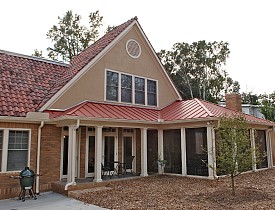Building a House to Fit Local Climate Conditions
 Before the invention of central heat and air conditioning, people generally built houses designed to be as comfortable and durable as possible for their specific climate. In hot climates, they built overhangs to shade windows and protect from rain, high ceilings to let the sultry air rise, porches to sit out on when the weather was scorching, and big windows to let in breezes. In cold climates, overhangs were smaller to let more sunshine into the house. In dry, desert areas, houses were made of masonry that would absorb heat during the day, releasing it at night.
Before the invention of central heat and air conditioning, people generally built houses designed to be as comfortable and durable as possible for their specific climate. In hot climates, they built overhangs to shade windows and protect from rain, high ceilings to let the sultry air rise, porches to sit out on when the weather was scorching, and big windows to let in breezes. In cold climates, overhangs were smaller to let more sunshine into the house. In dry, desert areas, houses were made of masonry that would absorb heat during the day, releasing it at night.
When we Americans started heating and cooling our homes, all those smart decisions fell by the wayside and we started building any type of house anywhere – southern cottages in the north, southwest adobe-style homes in the south, and on and on. However, appropriate roofing in Phoenix is not synonymous with appropriate roofing in Baltimore. What we are finding is that a house style in the wrong climate can lead to more energy use, and reduced comfort and durability.
For example, in the warm, rainy south, small overhangs (or none!) let in too much sun on hot days and allow large amounts of rainfall to hit the walls of the house, causing premature deterioration. Large overhangs in the north don’t let in enough of the sun’s heat on cold days. Thinking about where you live when you decide what kind of house to build is an easy way to make a better, greener home that will be cheaper to operate, more comfortable, and last longer – and none of this has to cost you a dime extra.
Just make the right decisions early in the house design and construction process. Here are some guidelines for climate-friendly roofing and window placement:
- If you get a lot of rain where you live, design your house with overhangs and simple roof designs to prevent water backing up into the attic and keep it off the walls.
- If you get a lot of snow, build a steep roof will allow the snow to slide off quickly instead of building up.
- In almost all climates, avoid west-facing windows; they heat up the house at the end of the day and can overheat even during cold weather. Some homeowners need to turn on the A/C in mid-winter because too much sun comes in!
- In cold climates, don’t put too many windows on the north side of the house, especially if you get a lot of wind from that direction. They will lose a lot of heat.
- Put lots of windows on the south side in all climates, shading them with overhangs to keep out heat during summer. Install easily openable windows, with screens if you live in a "buggy" area. Then open them (and turn off the AC) when the weather is nice. You don’t need to heat or air condition your house every minute of every day. Take advantage of natural heating or cooling, save money, and enjoy the day.
If you build or renovate your house to fit your local climate conditions, you can save energy, save money on maintenance, and be more comfortable year round. Why more people don’t do it is beyond me.
Green building consultant Carl Seville writes for Networx.
Updated March 1, 2018.
Looking for a Pro? Call us (866) 441-6648

Roofing Average Costs
Roofers Experiences

My Remodeled Bathroom Is Modern, Clean And Beautiful

Two Beautiful Bathroom Remodels, One At A Time



